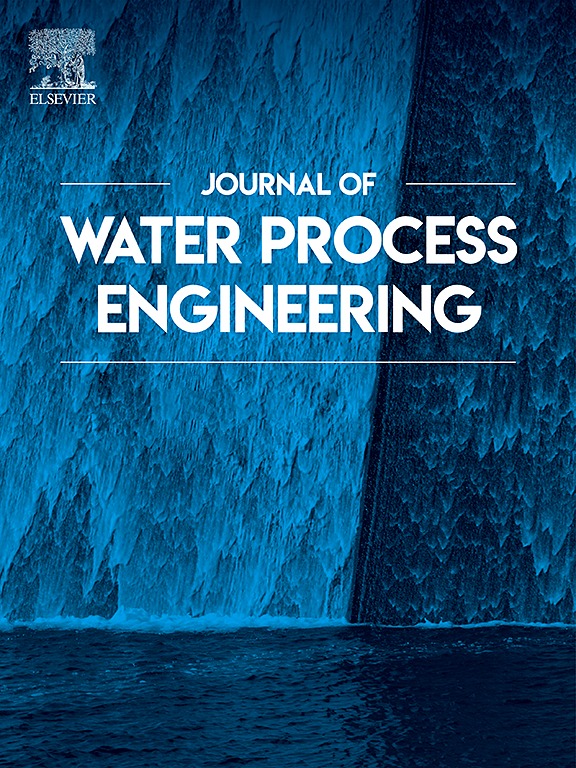Enhanced flux of nanofiltration membranes for low molecular weight solutes using Zr-MOF@MoS2 nanohybrids as both interlayer and filler materials
IF 6.7
2区 工程技术
Q1 ENGINEERING, CHEMICAL
引用次数: 0
Abstract
This study investigates the fabrication and performance of polyamide (PA) thin film composite (TFC) membranes for nanofiltration applications, incorporating nanosized (∼10 nm) zirconium-based metal-organic frameworks (MOFs) and MoS2. Three different Zr-MOFs, namely UiO-66, UiO-66-NH2 and MOF-808, were synthesized and anchored onto 2D MoS2 nanosheets forming MOF@MoS2 nanohybrids. These nanohybrids were integrated into PA TFC membranes using two distinct methods: (i) embedding them into the PA layer, resulting in thin film nanocomposite (TFN) membranes, and (ii) creating bilayered membranes with the nanohybrids beneath the PA layer. The membranes were evaluated for the removal of organic dyes, such as Rose Bengal (RB, 1017 Da), Sunset Yellow (SY, 452 Da) and Acridine Orange (AO, 265 Da), from water. The TFN membranes containing UiO-66@MoS2 nanohybrids exhibited the highest performance, with a water permeance of 12 L·m−2·h−1·bar−1 for the SY dye solution, representing a 140 % increase relative to the control PA TFC membrane. All membranes exhibited high rejection values (> 98 %), with performance strongly influenced by the dye size and charge. The characterization revealed that the porosity and sorption capacities of the nanohybrids are crucial to obtain more permeable membranes, but other factors such as negative surface charge, roughness and hydrophilicity play an important role.
利用Zr-MOF@MoS2纳米杂化物作为中间层和填充材料增强低分子量溶质纳滤膜的通量
本研究研究了用于纳滤应用的聚酰胺(PA)薄膜复合材料(TFC)膜的制备和性能,其中包含纳米(~ 10 nm)锆基金属有机框架(MOFs)和二硫化钼。合成了三种不同的Zr-MOFs,即uui -66、uui -66- nh2和MOF-808,并将其固定在二维MoS2纳米片上,形成MOF@MoS2纳米杂化物。这些纳米杂交体通过两种不同的方法集成到PA TFC膜中:(i)将它们嵌入PA层,形成薄膜纳米复合材料(TFN)膜,以及(ii)在PA层下与纳米杂交体形成双层膜。考察了膜对水中有机染料的去除率,如玫瑰红(RB, 1017 Da)、日落黄(SY, 452 Da)和吖啶橙(AO, 265 Da)。含有UiO-66@MoS2纳米杂化物的TFN膜表现出最高的性能,SY染料溶液的透水性为12 L·m−2·h−1·bar−1,相对于对照PA TFC膜提高了140%。所有膜都表现出较高的截留值(> 98%),其性能受到染料大小和电荷的强烈影响。表征结果表明,纳米杂化膜的孔隙度和吸附能力是获得高透膜的关键,但表面负电荷、粗糙度和亲水性等因素也起着重要作用。
本文章由计算机程序翻译,如有差异,请以英文原文为准。
求助全文
约1分钟内获得全文
求助全文
来源期刊

Journal of water process engineering
Biochemistry, Genetics and Molecular Biology-Biotechnology
CiteScore
10.70
自引率
8.60%
发文量
846
审稿时长
24 days
期刊介绍:
The Journal of Water Process Engineering aims to publish refereed, high-quality research papers with significant novelty and impact in all areas of the engineering of water and wastewater processing . Papers on advanced and novel treatment processes and technologies are particularly welcome. The Journal considers papers in areas such as nanotechnology and biotechnology applications in water, novel oxidation and separation processes, membrane processes (except those for desalination) , catalytic processes for the removal of water contaminants, sustainable processes, water reuse and recycling, water use and wastewater minimization, integrated/hybrid technology, process modeling of water treatment and novel treatment processes. Submissions on the subject of adsorbents, including standard measurements of adsorption kinetics and equilibrium will only be considered if there is a genuine case for novelty and contribution, for example highly novel, sustainable adsorbents and their use: papers on activated carbon-type materials derived from natural matter, or surfactant-modified clays and related minerals, would not fulfil this criterion. The Journal particularly welcomes contributions involving environmentally, economically and socially sustainable technology for water treatment, including those which are energy-efficient, with minimal or no chemical consumption, and capable of water recycling and reuse that minimizes the direct disposal of wastewater to the aquatic environment. Papers that describe novel ideas for solving issues related to water quality and availability are also welcome, as are those that show the transfer of techniques from other disciplines. The Journal will consider papers dealing with processes for various water matrices including drinking water (except desalination), domestic, urban and industrial wastewaters, in addition to their residues. It is expected that the journal will be of particular relevance to chemical and process engineers working in the field. The Journal welcomes Full Text papers, Short Communications, State-of-the-Art Reviews and Letters to Editors and Case Studies
 求助内容:
求助内容: 应助结果提醒方式:
应助结果提醒方式:


